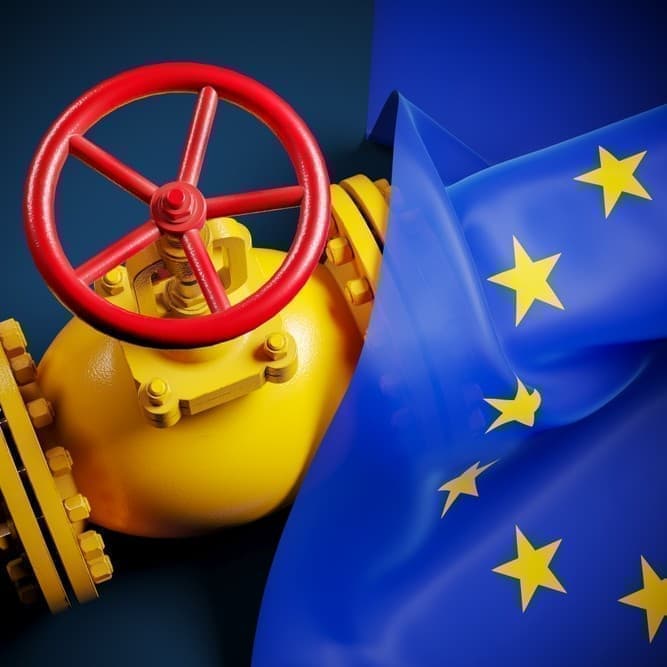European natural gas prices could more than double in 2024, Goldman Sachs says
Natural gas (also called fossil gas or simply gas) is a naturally occurring mixture of gaseous hydrocarbons consisting primarily of methane in addition to various smaller amounts of other higher alkanes. Low levels of trace gases like carbon dioxide, nitrogen, hydrogen sulfide, and helium are also usually present. Natural gas is colorless and odorless, so odorizes such as mercaptan (which smells like sulfur or rotten eggs) are commonly added to natural gas supplies for safety so that leaks can be readily detected.
Natural gas can be burned for heating, cooking, and electricity generation. It is also used as a chemical feedstock in the manufacture of plastics and other commercially important organic chemicals and less commonly used as a fuel for vehicles.
Natural gas can be found in underground geological formations, often alongside other fossil fuels like coal and oil (petroleum). Most natural gas has been created through either biogenic or thermogenic processes. Biogenic gas is formed when methanogenic organisms in marshes, bogs, landfills, and shallow sediments anaerobically decompose but are not subjected to high temperatures and pressures. Thermogenic gas takes a much longer period of time to form and is created when organic matter is heated and compressed deep underground.
During petroleum production, natural gas is sometimes flared rather than being collected and used. Before natural gas can be burned as a fuel or used in manufacturing processes, it almost always has to be processed to remove impurities such as water. The byproducts of this processing include ethane, propane, butanes, pentanes, and higher molecular weight hydrocarbons. Hydrogen sulfide (which may be converted into pure sulfur), carbon dioxide, water vapor, and sometimes helium and nitrogen must also be removed.
Natural gas is sometimes informally referred to simply as “gas”, especially when it is being compared to other energy sources, such as oil or coal. However, it is not to be confused with gasoline, which is often shortened in colloquial usage to “gas“, especially in North America.
Natural gas is measured in standard cubic meters or standard cubic feet. The density compared to air ranges from 0.58 (16.8 g/mole, 0.71 kg per standard cubic meter) to as high as 0.79 (22.9 g/mole, 0.97 kg per scm), but generally less than 0.64 (18.5 g/mole, 0.78 kg per scm).
For comparison, pure methane (16.0425 g/mole) has a density 0.5539 times that of air (0.678 kg per standard cubic meter).
European natural gas prices could “more than double” next year due to shortages caused by a drop in Russian exports, Goldman Sachs has said.
Greater storage capacities and an unusually warm winter have contributed to a sharp fall in European gas prices over the last few months.
Dutch Title Transfer Facility gas futures, the benchmark European contract, was trading at €52.70 ($55.81) per megawatt hour on Friday.
Futures hit a record high of about €343 a megawatt hour in August last year.
:quality(70)/cloudfront-eu-central-1.images.arcpublishing.com/thenational/VSXXT76SCZCWBLKW25UIJD7YZY.png)
Europe, which was severely affected by the cut-off of gas from Russia following the conflict, has managed to go through the winter without a major supply crunch.
However, the “structural deficit” in European natural gas balances has yet to be resolved and presents an upside risk to the region’s gas prices, Goldman Sachs said.
“It is not until 2025 that we expect the European energy crisis to find a more sustainable solution, when the next wave of global liquefied natural gas supply projects, currently under construction, starts to come online,” said the investment bank.
European countries have signed several LNG import agreements with the US and Gulf countries over the past few months.
Last week, Adnoc and German power company RWE announced the delivery of the first shipment of LNG from the UAE to Germany.
Last year in November, Qatar Energy signed two sales and purchase agreements with ConocoPhillips to deliver up to 2 million tones per annum (mtpa) of LNG to Germany.
On Tuesday, Freeport LNG, which is the second largest US exporter of LNG, said that federal regulators had given the green light for a partial resumption of commercial activities at its Texas-based plant after a fire led to its closure in June last year.
The return of the plant, which can process up to 2.1 billion cubic feet of natural gas per day and export 15 million tones of LNG per annum, is expected to push up domestic gas prices.
According to Wood Mackenzie, the resumption of operations at the Freeport plant will allow the US to become the top LNG exporter this year, surpassing Qatar and Australia, with an annual export capacity of 89 million metric tones.
US LNG capacity could expand annually by 70 million metric tones to 190 million metric tones by the end of the decade as several new projects come online, the energy consultancy said.
“Record-high prices and the need for energy security drove buyers, which included portfolio players and US producers and infrastructure companies, to seek long-term US LNG deals in 2022 and created huge contracting momentum for projects,” said Giles Farrer, head of gas and LNG asset research for Wood Mackenzie, in a report earlier this week.







